Singapore University PSY107: Article Analysis Tutor-Marked Assignment
VerifiedAdded on 2023/06/09
|7
|1468
|364
Homework Assignment
AI Summary
This assignment analyzes a research article titled "Do Young Drivers Become Safer After Being Involved in a Collision?" The study, published in Psychological Science in 2017, investigates whether young drivers reduce risky driving after experiencing a car collision. The research, conducted by O’Brien et al., involved 254 participants aged 16-17 years, whose driving behavior was monitored using data-acquisition systems with cameras and accelerometers. The researchers measured g-force events and collisions, finding that drivers involved in collisions showed a temporary reduction in g-force events, followed by a return to previous driving behaviors. The assignment answers questions about the study's aim, methods, hypothesis, and results, including suggestions for future research and the impact of educational programs. The abstract is rated based on its clarity and completeness, and relevant references are included. The study suggests that while collisions may initially influence driving behavior, the effects might not be long-lasting, highlighting the need for continued research on driving safety and educational interventions.

Running head: PSYCHOLOGY
Analysis of an article
Name of the Student
Name of the University
Author Note
Analysis of an article
Name of the Student
Name of the University
Author Note
Paraphrase This Document
Need a fresh take? Get an instant paraphrase of this document with our AI Paraphraser
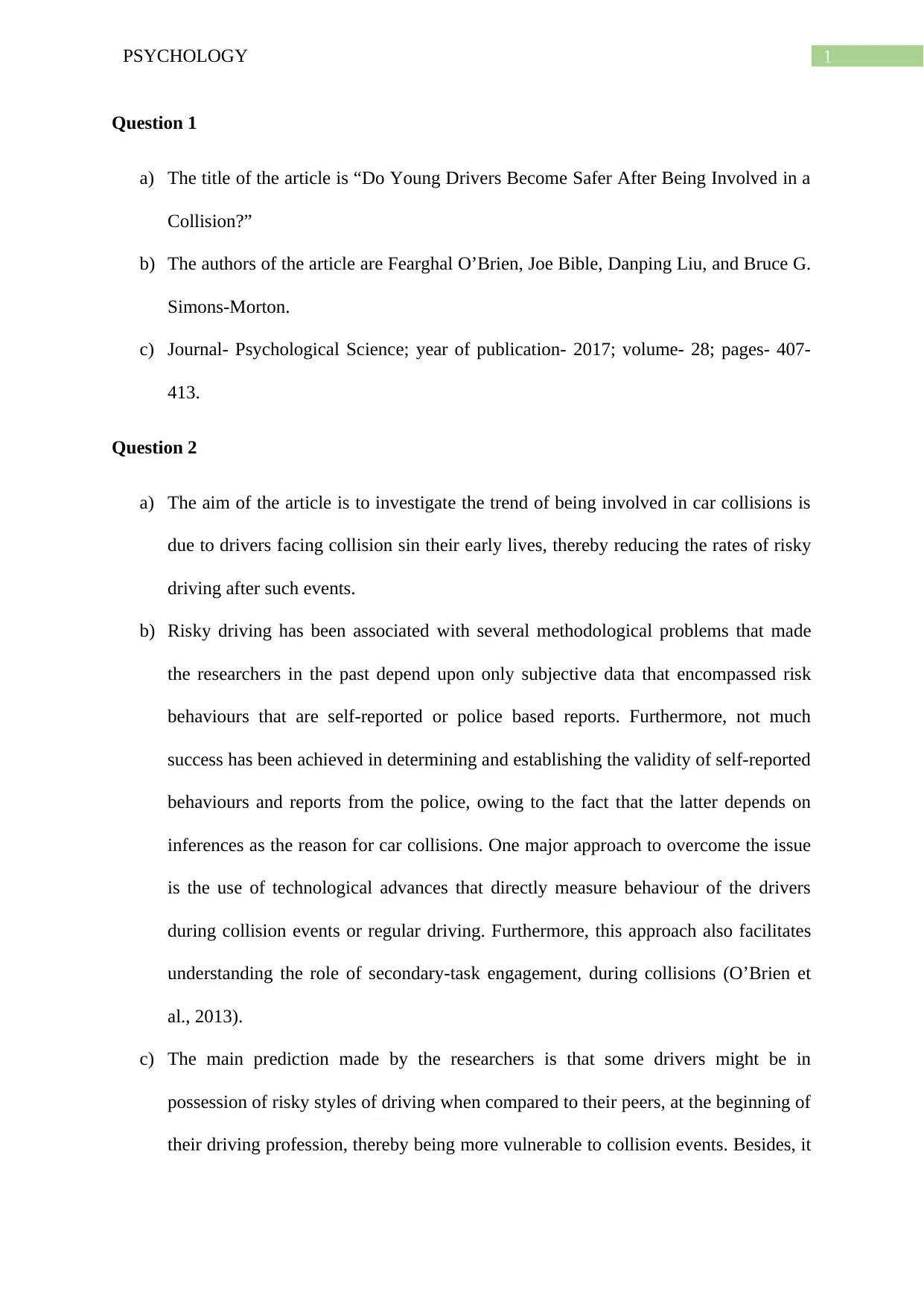
1PSYCHOLOGY
Question 1
a) The title of the article is “Do Young Drivers Become Safer After Being Involved in a
Collision?”
b) The authors of the article are Fearghal O’Brien, Joe Bible, Danping Liu, and Bruce G.
Simons-Morton.
c) Journal- Psychological Science; year of publication- 2017; volume- 28; pages- 407-
413.
Question 2
a) The aim of the article is to investigate the trend of being involved in car collisions is
due to drivers facing collision sin their early lives, thereby reducing the rates of risky
driving after such events.
b) Risky driving has been associated with several methodological problems that made
the researchers in the past depend upon only subjective data that encompassed risk
behaviours that are self-reported or police based reports. Furthermore, not much
success has been achieved in determining and establishing the validity of self-reported
behaviours and reports from the police, owing to the fact that the latter depends on
inferences as the reason for car collisions. One major approach to overcome the issue
is the use of technological advances that directly measure behaviour of the drivers
during collision events or regular driving. Furthermore, this approach also facilitates
understanding the role of secondary-task engagement, during collisions (O’Brien et
al., 2013).
c) The main prediction made by the researchers is that some drivers might be in
possession of risky styles of driving when compared to their peers, at the beginning of
their driving profession, thereby being more vulnerable to collision events. Besides, it
Question 1
a) The title of the article is “Do Young Drivers Become Safer After Being Involved in a
Collision?”
b) The authors of the article are Fearghal O’Brien, Joe Bible, Danping Liu, and Bruce G.
Simons-Morton.
c) Journal- Psychological Science; year of publication- 2017; volume- 28; pages- 407-
413.
Question 2
a) The aim of the article is to investigate the trend of being involved in car collisions is
due to drivers facing collision sin their early lives, thereby reducing the rates of risky
driving after such events.
b) Risky driving has been associated with several methodological problems that made
the researchers in the past depend upon only subjective data that encompassed risk
behaviours that are self-reported or police based reports. Furthermore, not much
success has been achieved in determining and establishing the validity of self-reported
behaviours and reports from the police, owing to the fact that the latter depends on
inferences as the reason for car collisions. One major approach to overcome the issue
is the use of technological advances that directly measure behaviour of the drivers
during collision events or regular driving. Furthermore, this approach also facilitates
understanding the role of secondary-task engagement, during collisions (O’Brien et
al., 2013).
c) The main prediction made by the researchers is that some drivers might be in
possession of risky styles of driving when compared to their peers, at the beginning of
their driving profession, thereby being more vulnerable to collision events. Besides, it
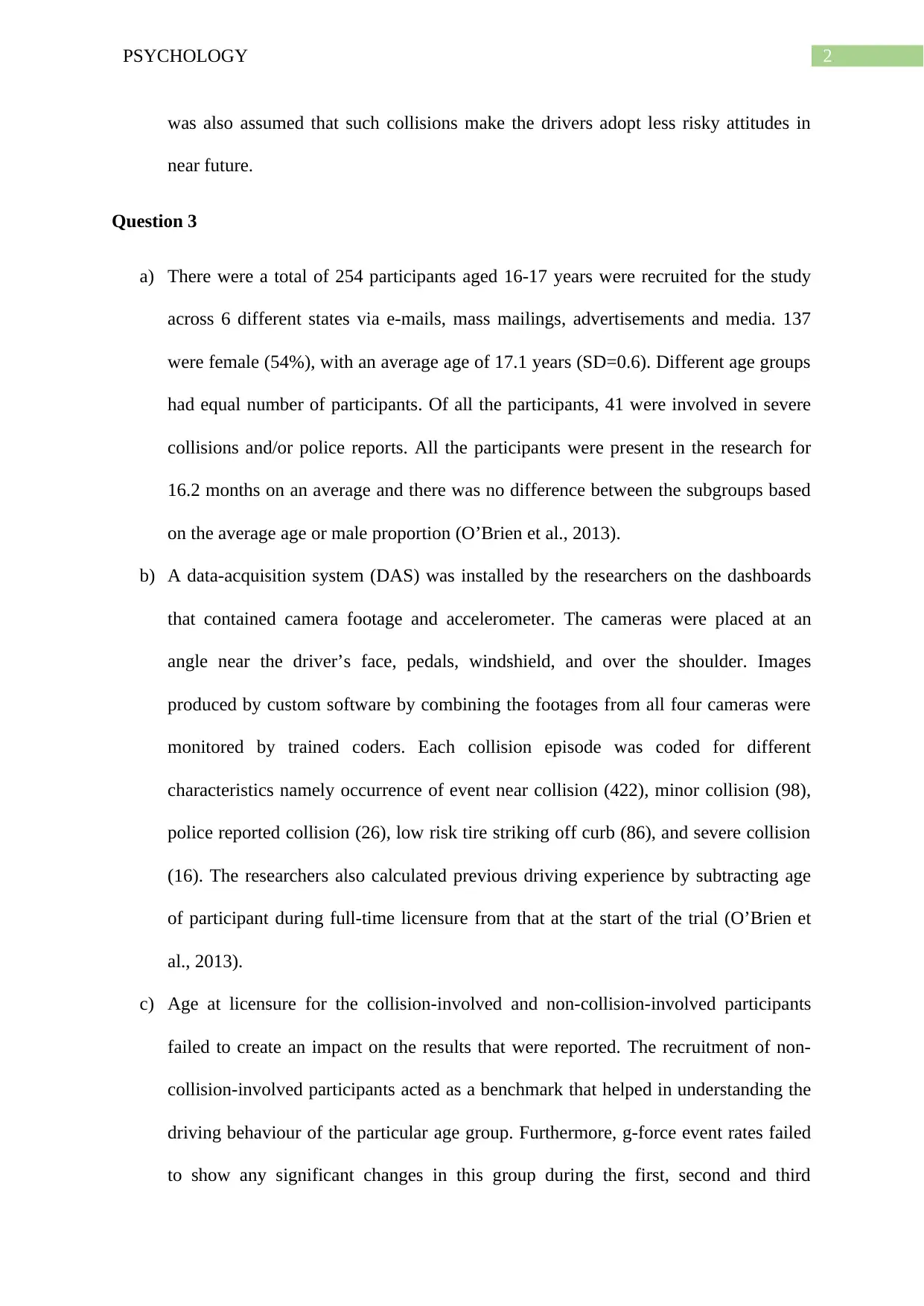
2PSYCHOLOGY
was also assumed that such collisions make the drivers adopt less risky attitudes in
near future.
Question 3
a) There were a total of 254 participants aged 16-17 years were recruited for the study
across 6 different states via e-mails, mass mailings, advertisements and media. 137
were female (54%), with an average age of 17.1 years (SD=0.6). Different age groups
had equal number of participants. Of all the participants, 41 were involved in severe
collisions and/or police reports. All the participants were present in the research for
16.2 months on an average and there was no difference between the subgroups based
on the average age or male proportion (O’Brien et al., 2013).
b) A data-acquisition system (DAS) was installed by the researchers on the dashboards
that contained camera footage and accelerometer. The cameras were placed at an
angle near the driver’s face, pedals, windshield, and over the shoulder. Images
produced by custom software by combining the footages from all four cameras were
monitored by trained coders. Each collision episode was coded for different
characteristics namely occurrence of event near collision (422), minor collision (98),
police reported collision (26), low risk tire striking off curb (86), and severe collision
(16). The researchers also calculated previous driving experience by subtracting age
of participant during full-time licensure from that at the start of the trial (O’Brien et
al., 2013).
c) Age at licensure for the collision-involved and non-collision-involved participants
failed to create an impact on the results that were reported. The recruitment of non-
collision-involved participants acted as a benchmark that helped in understanding the
driving behaviour of the particular age group. Furthermore, g-force event rates failed
to show any significant changes in this group during the first, second and third
was also assumed that such collisions make the drivers adopt less risky attitudes in
near future.
Question 3
a) There were a total of 254 participants aged 16-17 years were recruited for the study
across 6 different states via e-mails, mass mailings, advertisements and media. 137
were female (54%), with an average age of 17.1 years (SD=0.6). Different age groups
had equal number of participants. Of all the participants, 41 were involved in severe
collisions and/or police reports. All the participants were present in the research for
16.2 months on an average and there was no difference between the subgroups based
on the average age or male proportion (O’Brien et al., 2013).
b) A data-acquisition system (DAS) was installed by the researchers on the dashboards
that contained camera footage and accelerometer. The cameras were placed at an
angle near the driver’s face, pedals, windshield, and over the shoulder. Images
produced by custom software by combining the footages from all four cameras were
monitored by trained coders. Each collision episode was coded for different
characteristics namely occurrence of event near collision (422), minor collision (98),
police reported collision (26), low risk tire striking off curb (86), and severe collision
(16). The researchers also calculated previous driving experience by subtracting age
of participant during full-time licensure from that at the start of the trial (O’Brien et
al., 2013).
c) Age at licensure for the collision-involved and non-collision-involved participants
failed to create an impact on the results that were reported. The recruitment of non-
collision-involved participants acted as a benchmark that helped in understanding the
driving behaviour of the particular age group. Furthermore, g-force event rates failed
to show any significant changes in this group during the first, second and third
⊘ This is a preview!⊘
Do you want full access?
Subscribe today to unlock all pages.

Trusted by 1+ million students worldwide
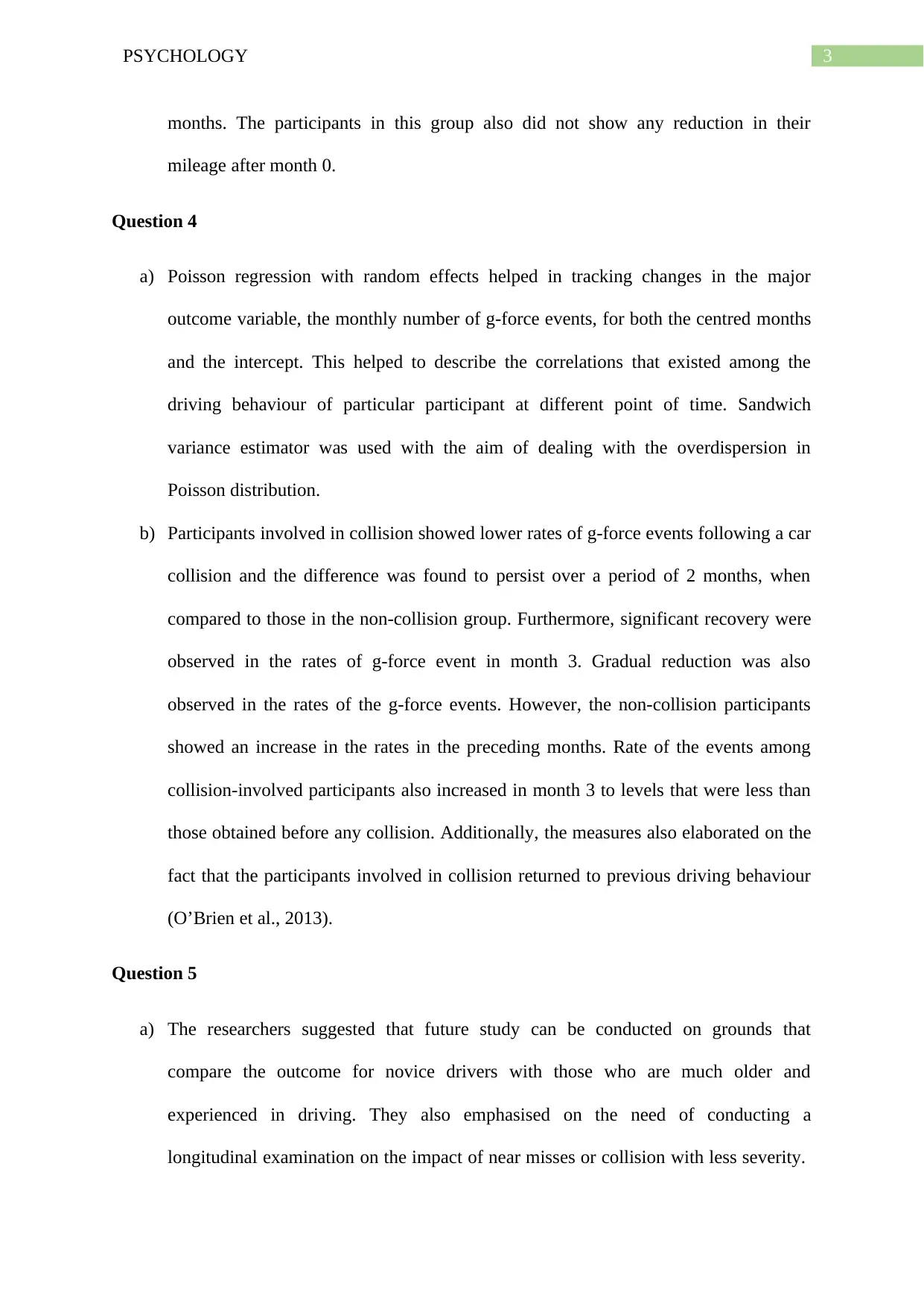
3PSYCHOLOGY
months. The participants in this group also did not show any reduction in their
mileage after month 0.
Question 4
a) Poisson regression with random effects helped in tracking changes in the major
outcome variable, the monthly number of g-force events, for both the centred months
and the intercept. This helped to describe the correlations that existed among the
driving behaviour of particular participant at different point of time. Sandwich
variance estimator was used with the aim of dealing with the overdispersion in
Poisson distribution.
b) Participants involved in collision showed lower rates of g-force events following a car
collision and the difference was found to persist over a period of 2 months, when
compared to those in the non-collision group. Furthermore, significant recovery were
observed in the rates of g-force event in month 3. Gradual reduction was also
observed in the rates of the g-force events. However, the non-collision participants
showed an increase in the rates in the preceding months. Rate of the events among
collision-involved participants also increased in month 3 to levels that were less than
those obtained before any collision. Additionally, the measures also elaborated on the
fact that the participants involved in collision returned to previous driving behaviour
(O’Brien et al., 2013).
Question 5
a) The researchers suggested that future study can be conducted on grounds that
compare the outcome for novice drivers with those who are much older and
experienced in driving. They also emphasised on the need of conducting a
longitudinal examination on the impact of near misses or collision with less severity.
months. The participants in this group also did not show any reduction in their
mileage after month 0.
Question 4
a) Poisson regression with random effects helped in tracking changes in the major
outcome variable, the monthly number of g-force events, for both the centred months
and the intercept. This helped to describe the correlations that existed among the
driving behaviour of particular participant at different point of time. Sandwich
variance estimator was used with the aim of dealing with the overdispersion in
Poisson distribution.
b) Participants involved in collision showed lower rates of g-force events following a car
collision and the difference was found to persist over a period of 2 months, when
compared to those in the non-collision group. Furthermore, significant recovery were
observed in the rates of g-force event in month 3. Gradual reduction was also
observed in the rates of the g-force events. However, the non-collision participants
showed an increase in the rates in the preceding months. Rate of the events among
collision-involved participants also increased in month 3 to levels that were less than
those obtained before any collision. Additionally, the measures also elaborated on the
fact that the participants involved in collision returned to previous driving behaviour
(O’Brien et al., 2013).
Question 5
a) The researchers suggested that future study can be conducted on grounds that
compare the outcome for novice drivers with those who are much older and
experienced in driving. They also emphasised on the need of conducting a
longitudinal examination on the impact of near misses or collision with less severity.
Paraphrase This Document
Need a fresh take? Get an instant paraphrase of this document with our AI Paraphraser
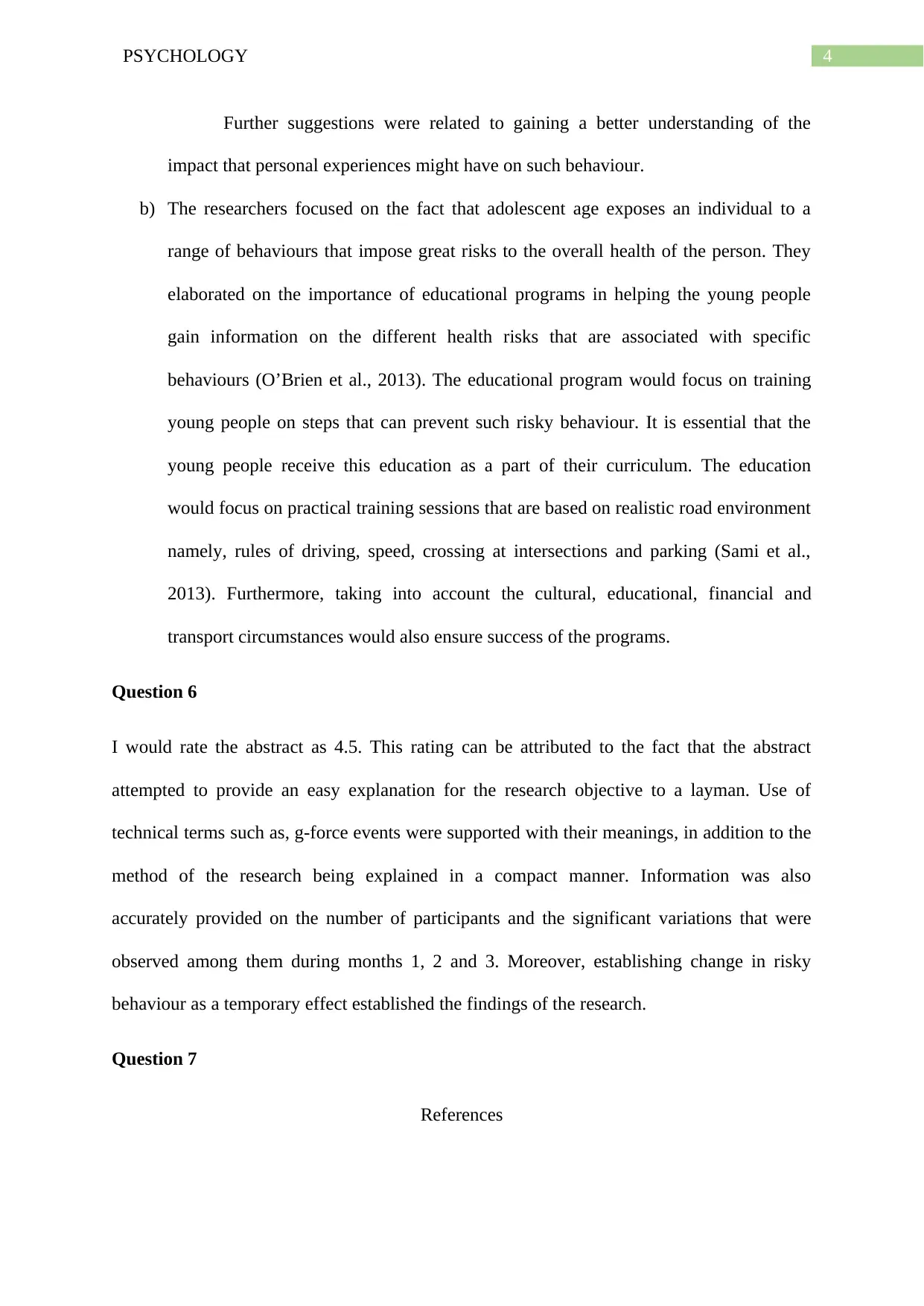
4PSYCHOLOGY
Further suggestions were related to gaining a better understanding of the
impact that personal experiences might have on such behaviour.
b) The researchers focused on the fact that adolescent age exposes an individual to a
range of behaviours that impose great risks to the overall health of the person. They
elaborated on the importance of educational programs in helping the young people
gain information on the different health risks that are associated with specific
behaviours (O’Brien et al., 2013). The educational program would focus on training
young people on steps that can prevent such risky behaviour. It is essential that the
young people receive this education as a part of their curriculum. The education
would focus on practical training sessions that are based on realistic road environment
namely, rules of driving, speed, crossing at intersections and parking (Sami et al.,
2013). Furthermore, taking into account the cultural, educational, financial and
transport circumstances would also ensure success of the programs.
Question 6
I would rate the abstract as 4.5. This rating can be attributed to the fact that the abstract
attempted to provide an easy explanation for the research objective to a layman. Use of
technical terms such as, g-force events were supported with their meanings, in addition to the
method of the research being explained in a compact manner. Information was also
accurately provided on the number of participants and the significant variations that were
observed among them during months 1, 2 and 3. Moreover, establishing change in risky
behaviour as a temporary effect established the findings of the research.
Question 7
References
Further suggestions were related to gaining a better understanding of the
impact that personal experiences might have on such behaviour.
b) The researchers focused on the fact that adolescent age exposes an individual to a
range of behaviours that impose great risks to the overall health of the person. They
elaborated on the importance of educational programs in helping the young people
gain information on the different health risks that are associated with specific
behaviours (O’Brien et al., 2013). The educational program would focus on training
young people on steps that can prevent such risky behaviour. It is essential that the
young people receive this education as a part of their curriculum. The education
would focus on practical training sessions that are based on realistic road environment
namely, rules of driving, speed, crossing at intersections and parking (Sami et al.,
2013). Furthermore, taking into account the cultural, educational, financial and
transport circumstances would also ensure success of the programs.
Question 6
I would rate the abstract as 4.5. This rating can be attributed to the fact that the abstract
attempted to provide an easy explanation for the research objective to a layman. Use of
technical terms such as, g-force events were supported with their meanings, in addition to the
method of the research being explained in a compact manner. Information was also
accurately provided on the number of participants and the significant variations that were
observed among them during months 1, 2 and 3. Moreover, establishing change in risky
behaviour as a temporary effect established the findings of the research.
Question 7
References
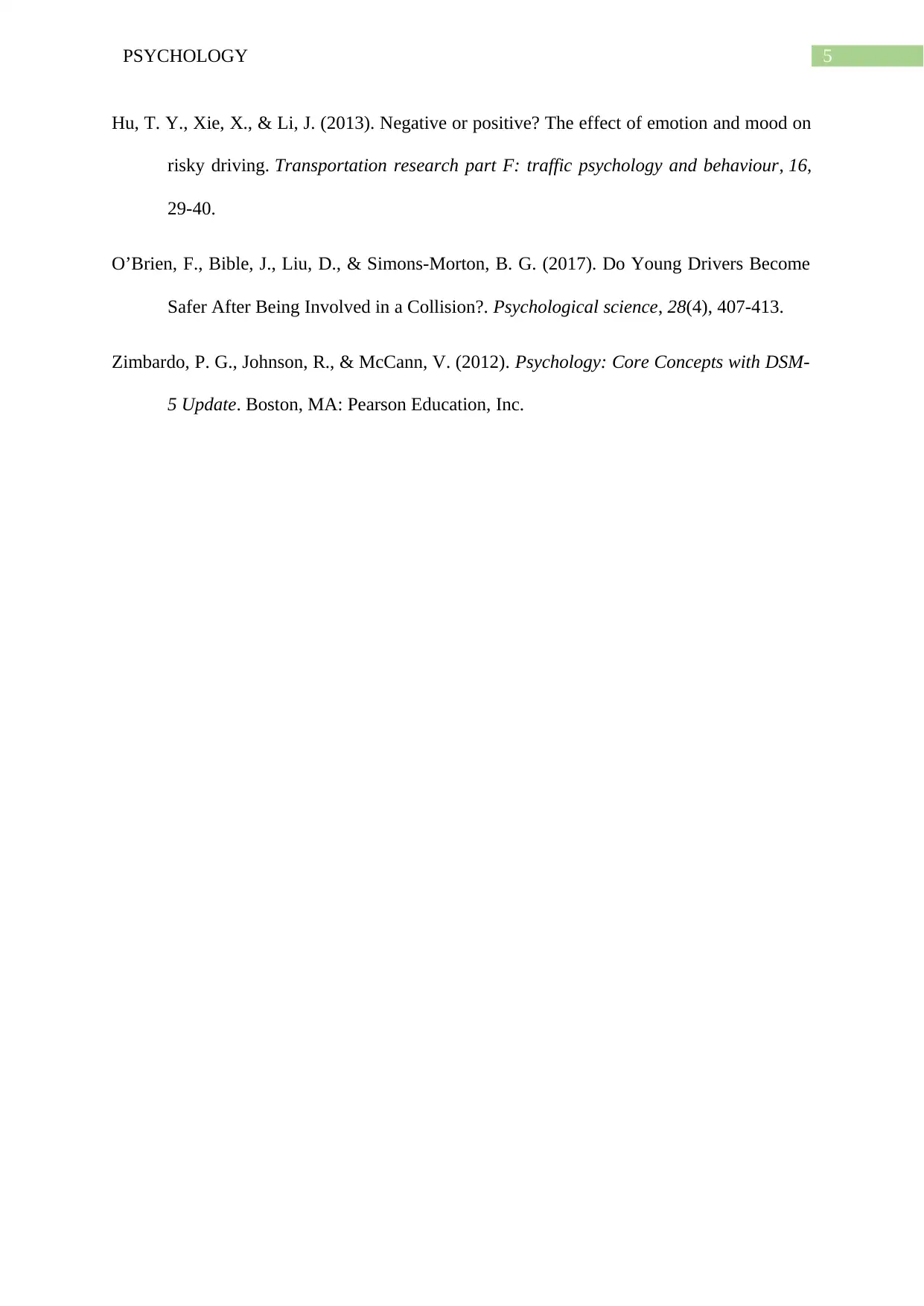
5PSYCHOLOGY
Hu, T. Y., Xie, X., & Li, J. (2013). Negative or positive? The effect of emotion and mood on
risky driving. Transportation research part F: traffic psychology and behaviour, 16,
29-40.
O’Brien, F., Bible, J., Liu, D., & Simons-Morton, B. G. (2017). Do Young Drivers Become
Safer After Being Involved in a Collision?. Psychological science, 28(4), 407-413.
Zimbardo, P. G., Johnson, R., & McCann, V. (2012). Psychology: Core Concepts with DSM-
5 Update. Boston, MA: Pearson Education, Inc.
Hu, T. Y., Xie, X., & Li, J. (2013). Negative or positive? The effect of emotion and mood on
risky driving. Transportation research part F: traffic psychology and behaviour, 16,
29-40.
O’Brien, F., Bible, J., Liu, D., & Simons-Morton, B. G. (2017). Do Young Drivers Become
Safer After Being Involved in a Collision?. Psychological science, 28(4), 407-413.
Zimbardo, P. G., Johnson, R., & McCann, V. (2012). Psychology: Core Concepts with DSM-
5 Update. Boston, MA: Pearson Education, Inc.
⊘ This is a preview!⊘
Do you want full access?
Subscribe today to unlock all pages.

Trusted by 1+ million students worldwide

6PSYCHOLOGY
References
O’Brien, F., Bible, J., Liu, D., & Simons-Morton, B. G. (2017). Do Young Drivers Become
Safer After Being Involved in a Collision?. Psychological science, 28(4), 407-413.
Sami, A., Moafian, G., Najafi, A., Aghabeigi, M. R., Yamini, N., Heydari, S. T., &
Lankarani, K. B. (2013). Educational level and age as contributing factors to road
traffic accidents. Chin J Traumatol, 16(5), 281-5.
References
O’Brien, F., Bible, J., Liu, D., & Simons-Morton, B. G. (2017). Do Young Drivers Become
Safer After Being Involved in a Collision?. Psychological science, 28(4), 407-413.
Sami, A., Moafian, G., Najafi, A., Aghabeigi, M. R., Yamini, N., Heydari, S. T., &
Lankarani, K. B. (2013). Educational level and age as contributing factors to road
traffic accidents. Chin J Traumatol, 16(5), 281-5.
1 out of 7
Your All-in-One AI-Powered Toolkit for Academic Success.
+13062052269
info@desklib.com
Available 24*7 on WhatsApp / Email
![[object Object]](/_next/static/media/star-bottom.7253800d.svg)
Unlock your academic potential
Copyright © 2020–2025 A2Z Services. All Rights Reserved. Developed and managed by ZUCOL.